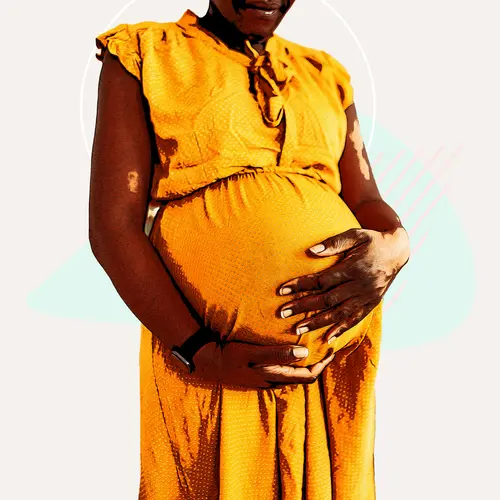The way you carry has everything to do with the tone of your abdominal muscles, body shape, and a few other factors. The general size and shape of your belly don’t have much to do with your baby, their health, or their size. A healthy baby can grow regardless of how your belly looks. The way you carry has more to do with you than it has to do with your baby. If you're worried about the size or shape of your baby bump, talk to your doctor.
How Are You Carrying?
Depending on how your bump feels or looks to you or others, you could be carrying low, high, small, large, or wide.
Carrying low vs. high. Carrying high or low has been long associated with guessing a baby’s sex. Mothers who carry high are thought to have girls, whereas mothers who carry low are thought to have boys.
But according to Kirtly Parker Jones, OB/GYN, there's no truth in that. A first pregnancy may look higher since your abdominal wall isn't yet stretched out. With each pregnancy after your first, the abdominal wall gets stretched out and your baby may appear to be carried lower.
Carrying small vs. large. A big bump more likely means you have weaker abdominal muscles or a shorter stature. It can also signal a noncancerous growth in your uterus called fibroids. Because pregnancy hormones tend to make fibroids grow, they may cause you to show larger than the baby’s gestational age. And your bump may have a somewhat lumpy appearance.
Carrying wide. If your baby lies horizontally (also known as a transverse lie), it could show as if you’re carrying wide. This position is common before 26 weeks, but by week 35 your baby should be head-down in the ready position for birth.
Why You’re Carrying Small, Low, High, Large, or Wide
Several factors can affect how you carry your baby and when you start to show.
Diastasis recti. Sometimes in pregnancy, when the uterus grows upward, your abs stretch and split open. This is called diastasis recti or abdominal separation. Your abdomen may seem to sag, which to you or someone looking at you may appear as if you're carrying low.
Your height. Taller women tend to carry small and show later than shorter women. The reason is that taller mothers have a longer midsection. If you’re tall, you have more up-and-down room between the pubic bone and the top of your abdomen. It allows for pregnancy weight to distribute more evenly. If you're short, there’s a good chance you’ll carry low and around your middle.
Body shape and weight. Sometimes, due to body shape, pregnant bellies can create an optical illusion. So it's not strange to notice your bump seems bigger or smaller than your friend’s bump when really they’re the same size. You do add about 30 pounds of body weight during pregnancy. This could be a reason people think you’re carrying large or wide.
Muscle tone. It's important to exercise before, during, and after pregnancy. If you have tight abs, they'll offer more support and lift to your growing uterus. As a result, you may appear to carry higher, especially for first pregnancy. Strong abs hold your baby more into the body. This may cause your baby bump to appear smaller or stick out less.
Multiples. If you’re expecting more than one baby, your pregnant belly will grow differently to accommodate twins or triplets. Don’t be surprised if you show earlier than expected or your tummy grows to be quite big. Also, if this isn't your first pregnancy, you might show a baby bump sooner than you did with your first pregnancy and carry a bit differently.
Oligohydramnios. This condition causes you to have too little amniotic fluid. If you have this condition, your bump may look small. Your doctor will confirm the diagnosis if they test and find that you have less than 500 milliliters of fluid at 32 to 36 weeks gestation. If you're past your due date by two weeks or more, you may be at risk for low amniotic fluid levels.
It's normal for fluids to decrease by half once you reach 42 weeks gestation. If it happens early in pregnancy, some complications involved include compression of fetal organs resulting in birth defects, and an increased chance of miscarriage, preterm birth, or stillbirth.
Polyhydramnios. This condition occurs when excess amniotic fluid accumulates in the uterus during pregnancy. One symptom of the condition is carrying large. You may feel huge or tightness in the belly and experience other complications like difficulty breathing and constipation. While inside the womb, your baby will swallow amniotic fluid and then urinate it out. It helps to keep the amount of amniotic fluid at a steady level. If your baby cannot swallow due to a genetic defect, amniotic fluid will build up.
Stage of pregnancy. Your bump keeps growing during your pregnancy — from the size of a grapefruit to a papaya to a watermelon. When you reach full term, your uterus extends from the pubic area to the bottom of your rib cage.
Some women don’t show until their second trimester. You could start showing a small bump at first then experience rapid growth through the second and third trimesters. But it doesn’t mean there's anything wrong.
If you don’t have any other pregnancy complications, the size of your bump shouldn’t worry you. During the second half of pregnancy, your doctor will measure your fundal height, which is the length of your uterus from top to bottom. At this point, they'll be in a position to tell you if there's anything wrong with how you’re carrying.


